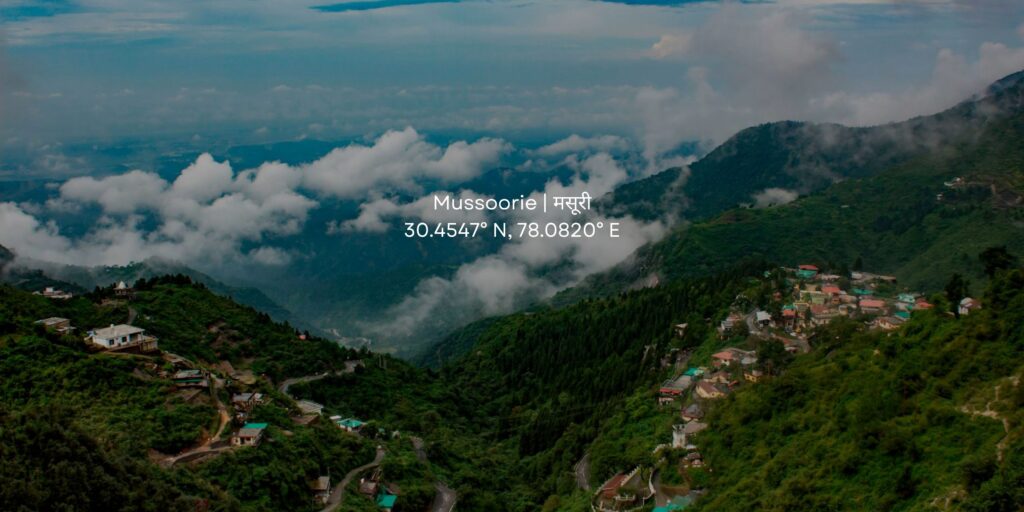
Mussoorie in August – A Complete Travel Guide 2025
Mussoorie in August is where the monsoon breathes life into the hills, painting every corner in vivid shades of green. This colonial-era hill station, often called the Queen of Hills, becomes a misty retreat where clouds drift through pine forests, waterfalls roar with fresh rainwater, and quiet trails glisten under the canopy of oak and deodar trees.
While many travelers shy away from monsoons in other places, Mussoorie wears August like a charm. The town slows down just enough to give you space—fewer crowds, better hotel deals, and a front-row seat to nature’s most theatrical season. The Mussoorie weather in August is cool, refreshing, and romantic, with temperatures ranging between 17°C to 24°C, perfect for misty strolls and steaming cups of chai by a mountainside café.
What makes this time truly special is the mood—low-hanging clouds wrap around Landour’s winding roads, waterfalls like Kempty and Jharipani come alive, and local flora bloom in full glory. Whether you’re on a monsoon getaway, honeymoon, or solo retreat, August in Mussoorie offers a side of the hill town that’s serene, soulful, and soaked in natural beauty.
So if you’re wondering whether it’s worth taking a Mussoorie trip in August, the answer is yes—if you crave quiet green landscapes, monsoon charm, and a break from the typical tourist rush.
Is It Safe to Travel to Mussoorie in August?
If you’re wondering “is it safe to travel to Mussoorie in August?”, the answer is yes — with a few smart precautions and realistic expectations. August in Mussoorie falls right in the heart of the monsoon season, which brings lush green landscapes, misty hills, and gushing waterfalls — but also the occasional challenges that come with mountain rains.
Rain showers in Mussoorie during August are usually moderate and scattered, not relentless. While there might be a few heavy spells, they’re often short-lived and followed by clearer skies and a refreshing drop in temperature. The average climate in Mussoorie in August stays cool and pleasant, between 17°C to 24°C, making it a comfortable escape from the heat of the plains.
Now, is there a risk of landslides? In remote or less-maintained areas, yes, it can happen. But central Mussoorie — including places like Mall Road, Landour, and most popular attractions — remains accessible and safe. Roads to and from Dehradun are mostly well-managed, although it’s wise to check weather updates and avoid late-night or unnecessary hill drives during heavy rain days.
One big advantage of visiting in August is that the crowds are fewer, the vibe is quieter, and hotels often drop their rates. The town feels more personal, and you’ll find locals more relaxed and welcoming without the summer tourist rush.
So yes, traveling to Mussoorie in August is safe, as long as you plan smart — check weather forecasts, avoid risky treks during heavy showers, carry the right clothing and gear, and give yourself some buffer time while commuting. In return, you’ll experience Mussoorie at its most scenic, soulful, and wonderfully green.
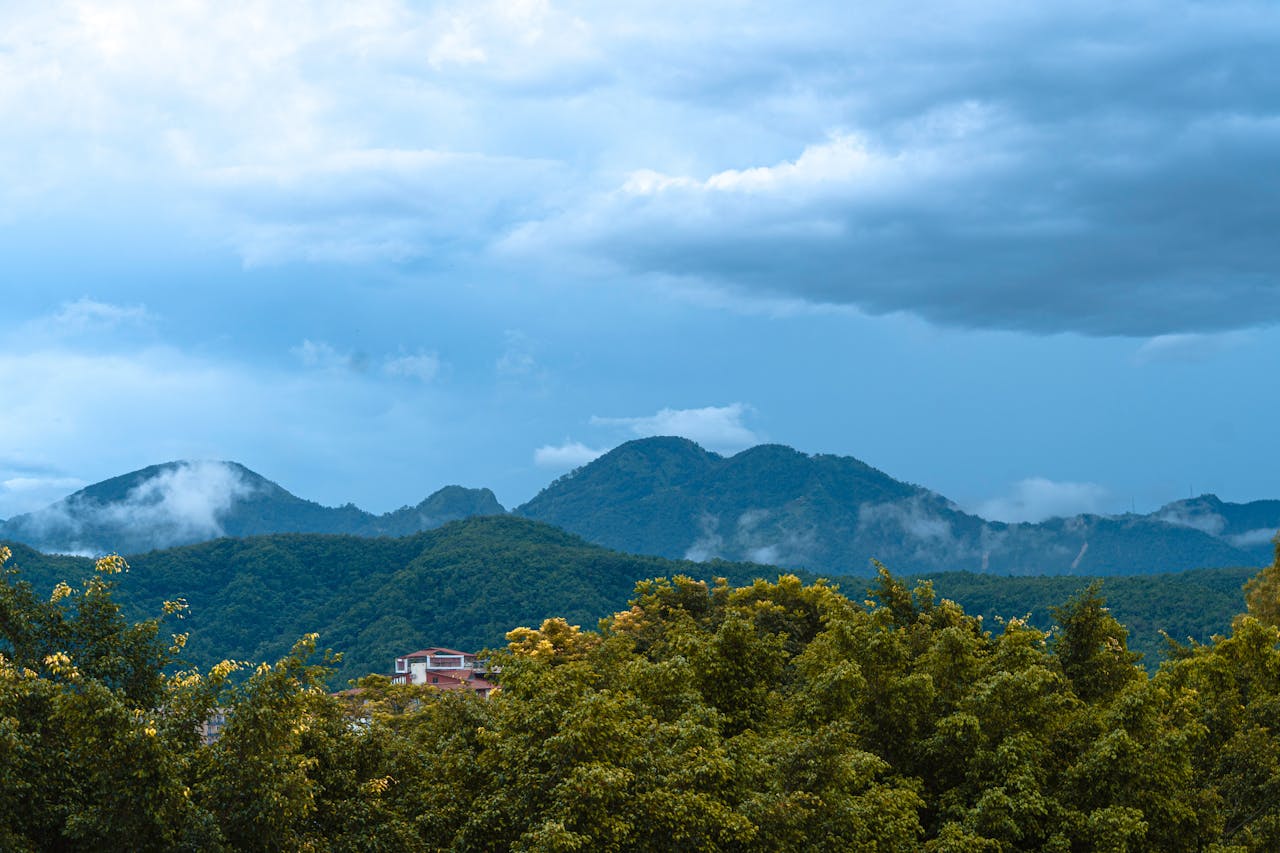
Mussoorie Weather in August – What to Expect
The weather in Mussoorie in August offers a mix of monsoon magic and mountain coolness that transforms the hill station into a lush green wonderland. If you’re visiting during this time, prepare to witness Mussoorie at its most romantic and raw — veiled in mist, wrapped in clouds, and surrounded by the sound of cascading water from every slope.
Daytime temperatures in August usually hover between 21°C to 24°C, while the nights cool down to a pleasant 16°C to 18°C. There’s no intense heat here — the sun, when it appears between cloud breaks, feels mild and welcome. The humidity is moderate to high, especially after fresh rain, but Mussoorie’s elevation (around 2,000 meters above sea level) ensures it never feels oppressive like the plains below.
Rainfall is frequent throughout the month, with Mussoorie receiving about 500mm to 600mm of rain in August on average. But these showers are usually intermittent — not the kind that ruins a full day. You’ll often find the skies shifting between light drizzles, sudden downpours, and bright clearings that bring out brilliant rain-washed landscapes. The rains breathe life into the region’s forests, valleys, and waterfalls, making everything feel cleaner, quieter, and greener.
Fog and low-lying clouds are also common, especially in the mornings and late afternoons. This adds to the charm but also reduces visibility on some days, particularly on winding roads and hilltop viewpoints. Still, the views you do catch — like of the Doon Valley from George Everest or mist rolling through Landour — are nothing short of cinematic.
The weather also has practical implications. You’ll need waterproof shoes, a reliable umbrella or raincoat, and layers to stay comfortable as temperatures shift throughout the day. Roads can get slippery, and walking paths—especially through forested areas or to waterfalls—might require extra caution. But for those who embrace the monsoon vibe, the atmosphere is incredibly peaceful and rejuvenating.
In short, Mussoorie’s climate in August is not for sun-chasers or strict itineraries — it’s for those who enjoy a more laid-back, nature-connected, and soulful travel experience. You trade bright skies for drifting clouds, noise for stillness, and crowds for space. And that’s what makes it so special.
Places to Visit in Mussoorie in August: 10 Best Places That You can't Miss
August brings a special kind of magic to Mussoorie — the clouds descend over pine-covered hills, waterfalls tumble in full force, and the crowds from peak summer begin to thin out. If you’re planning a trip this month, you’ll be greeted by lush greenery, cool mountain air, and peaceful surroundings that are rarely seen during other times of the year.
While some remote trekking routes might be risky due to rain, the main attractions of Mussoorie in August remain safe, accessible, and incredibly scenic. This is the perfect time to experience Mussoorie’s natural beauty, colonial charm, and peaceful hill-station vibe — just be ready with an umbrella and waterproof shoes.
Let’s explore some of the best places to visit in Mussoorie in August, starting with one of its most iconic attractions.
1. Kempty Falls
If there’s one place that truly comes alive during the monsoon, it’s Kempty Falls — Mussoorie’s most famous waterfall. Surrounded by steep green cliffs and echoing with the roar of cascading water, this natural attraction turns into a monsoon marvel in August.
The water volume increases significantly this time of year, making it a dramatic sight and a perfect photo opportunity. While the lower pool may be too rough for swimming during peak rains, the surrounding views and cool mist in the air make it worth the visit. The falls are surrounded by small stalls and eateries, so you can enjoy local snacks like hot Maggi or momos while soaking in the view.
If you arrive early in the day, you’ll find it relatively less crowded, especially during weekdays.
🕒 Opening Hours: 8:00 AM – 5:00 PM
🎟️ Entry Fee: No entry fee, but ropeway tickets (optional) start around ₹100–₹150
📍 How to Reach: 15 km from Mussoorie town; easily accessible via taxi or local bus
Why Visit in August?
The monsoon enhances the beauty of the falls dramatically — they’re louder, fuller, and more photogenic than any other time of year. Just be cautious of slippery steps and wear waterproof footwear.

Kempty Falls, Mussoorie
2. Company Garden
Located just 3 km from Mall Road, Company Garden (also known as Municipal Garden) is one of the most family-friendly and relaxing places to visit in Mussoorie in August. While it’s popular year-round, this colonial-era garden becomes especially scenic during the monsoon — with freshly bloomed flowers, mist floating over lawns, and vibrant greenery all around.
The garden is well-maintained and has paved walkways, so it remains easy to explore even in wet conditions. It features a mini lake with paddle boating, a small amusement area for kids, lush lawns, and a variety of seasonal flowers that bloom in bright colors during August. The air feels especially fresh after light showers, and the entire area is surrounded by tall deodar and oak trees — giving it a soothing, rain-kissed atmosphere.
You’ll also find several food stalls inside serving snacks like hot pakoras, corn, and momos — perfect for a warm bite on a misty afternoon.
🕒 Opening Hours: 9:00 AM – 6:00 PM
🎟️ Entry Fee: ₹25 per person
📍 How to Reach: 3 km from Mall Road; reachable via cab, rickshaw, or a short trek
Why Visit in August?
The monsoon rains breathe life into the garden — making it greener, quieter, and more serene. It’s a perfect spot for couples, families, or anyone looking to enjoy nature without venturing far from the town center.
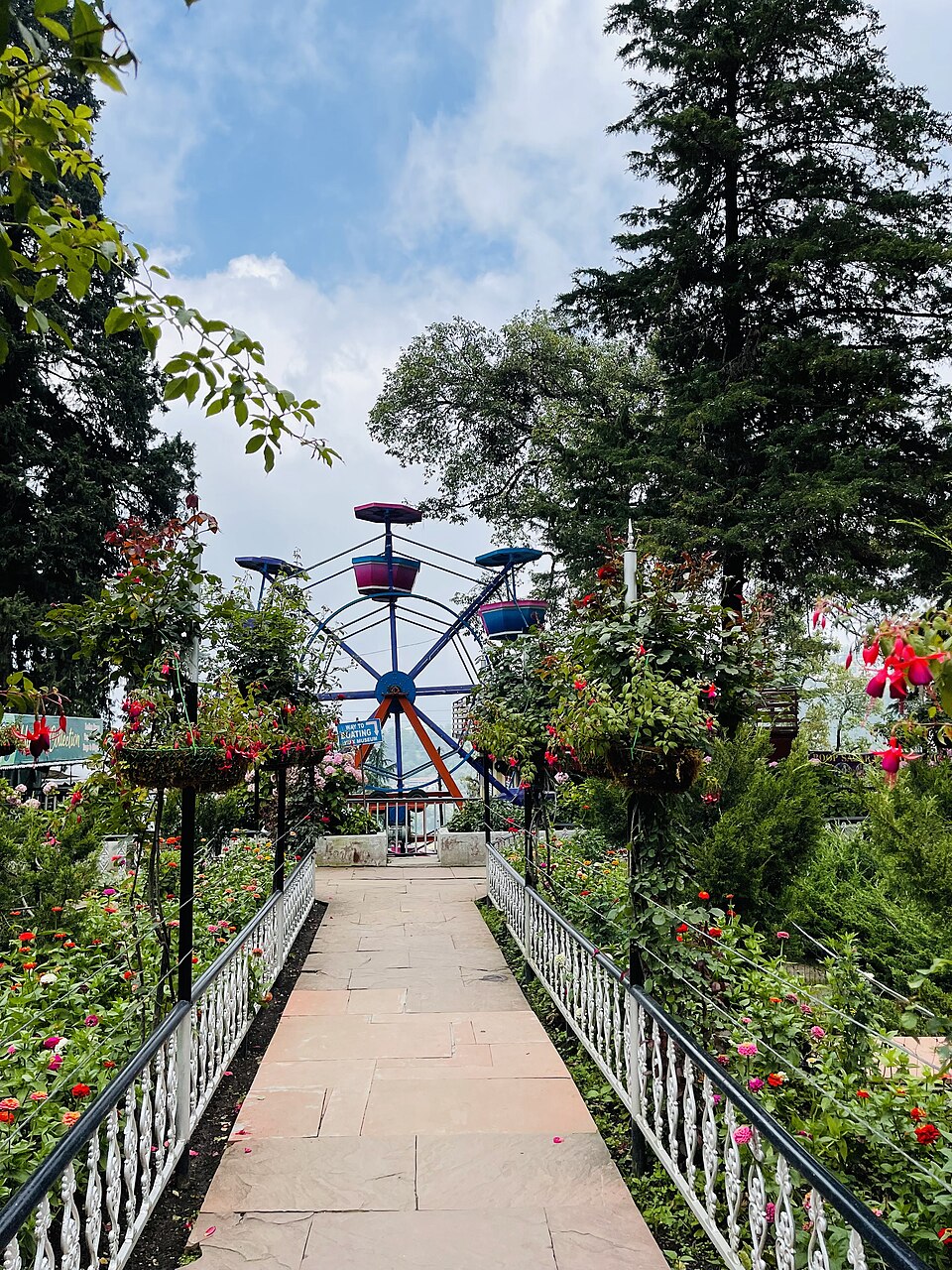
Company Garden Mussoorie
3. George Everest Estate
A visit to George Everest Estate is one of the most rewarding experiences in Mussoorie — and in recent years, it has undergone a complete transformation. Named after Sir George Everest, the British Surveyor General of India, this scenic hilltop estate has now evolved into a beautiful blend of heritage, nature, and adventure. Located on a quiet ridge with sweeping views of the Doon Valley on one side and the Himalayas on the other, it’s a must-visit — especially in August.
This time of year, the monsoon mist lingers over the valley, making the short uphill trail to the estate incredibly atmospheric. The greenery is at its peak, the sky shifts dramatically between sun and fog, and the air is crisp and fresh. The colonial-era house, now restored, also features a Cartography Museum that gives insight into Sir Everest’s survey work — adding a layer of history to the visit.
But the biggest change? The addition of adventure activities on-site. You can now enjoy zip-lining, sky bridges, rock climbing, rappelling, and even helicopter rides over the valley. The surrounding trails are also great for nature walks, photography, and a peaceful moment away from the tourist bustle of Mall Road.
🕒 Opening Hours: 10:00 AM – 6:00 PM
🎟️ Entry Fee: ₹200 per person (Indian adults), ₹100 for kids, ₹600 for foreign tourists
🚘 Parking Fee: ₹100 for two-wheelers, ₹300 for four-wheelers
📍 How to Reach: 6 km from Library Chowk; accessible by cab, bike, or a short trek from Hathipaon
Why Visit in August?
The lush monsoon greenery and fog-wrapped trails make this estate feel otherworldly. It’s far less crowded than summer, and with the new museum and adventure park, it offers something for every kind of traveler — from history buffs and photographers to thrill seekers.
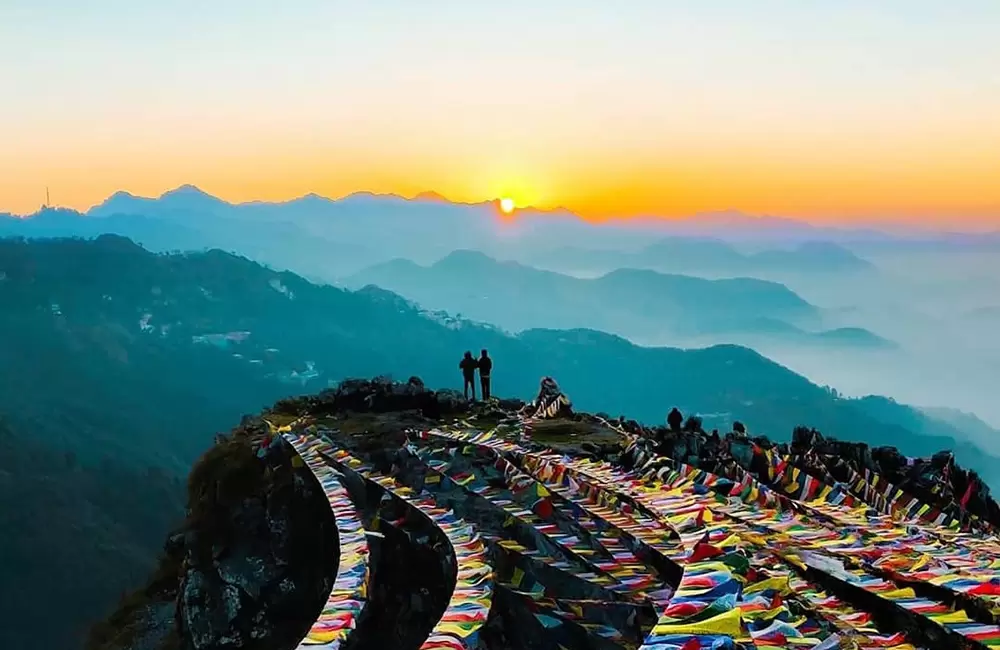
George Everest
4. Cloud’s End
One of the most peaceful and scenic places to visit in Mussoorie in August, Cloud’s End marks the beautiful western edge of the hill station, perched amidst dense oak, deodar, and cedar forests. At around 2,100 m elevation, the name lives up to itself—clouds often drift right through the trees, especially after August showers, creating an ethereal “end of the world” atmosphere.
In August, the weather is perfect for exploring: temperatures hover between 17°C–24°C, with moderate rainfall that freshens the forest without making it too slippery. Morning or late afternoon hikes reveal mist-laden trails and panoramic views of the Aglar River Valley and distant Himalayan peaks—ideal for photographers, nature lovers, and anyone looking to disconnect from the noise of daily life.
🕒 Opening Hours: Open 24 hours
🎟️ Entry Fee: ₹50 per adult (children may enter for free)
📍 How to Reach: About 6–7 km west of Library Bazaar via the Hathipaon–Happy Valley route; accessible by car, bike, or a scenic walk
What to Expect in August:
You’ll be greeted by lush green trails, fog-filled valleys, and the peaceful chirping of Himalayan birds. Cloud’s End is also home to a British-era colonial bungalow, now functioning as a heritage property, making it a lovely stop for history and architecture buffs. It also serves as the starting point for hikes to Jwala Devi Temple or Benog Wildlife Sanctuary — both rewarding nature walks if the weather permits.
Why Visit in August?
With the rains reviving every tree and trail, and mist adding mystery to every corner, Cloud’s End in August offers a quiet, green, and soul-refreshing experience. The monsoon transforms it into a living postcard — serene, silent, and endlessly scenic.
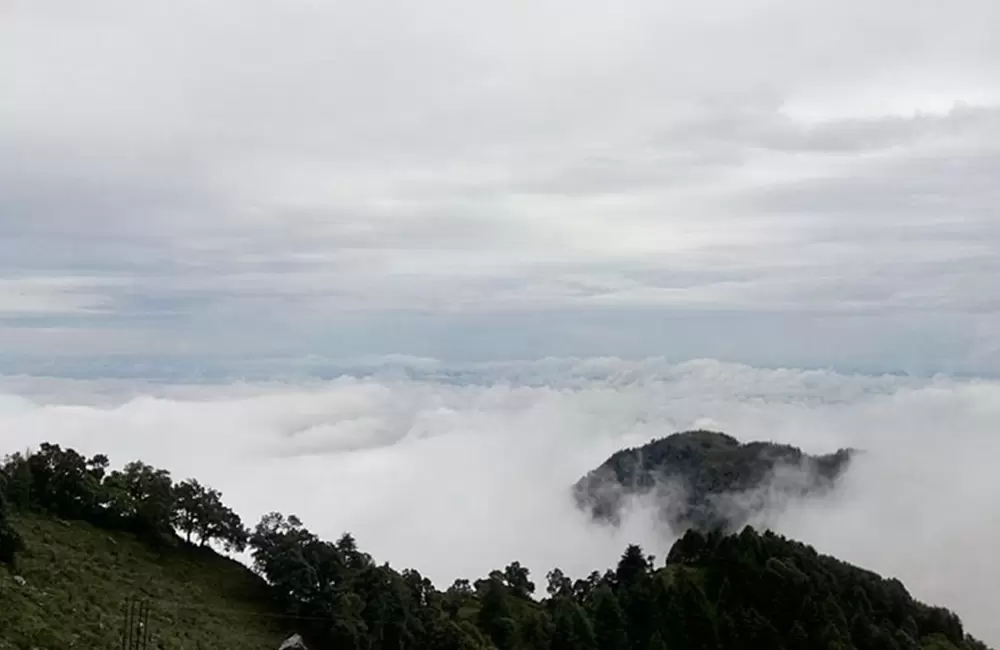
Cloud’s End
5. Gun Hill, Mussoorie
One of Mussoorie’s most iconic viewpoints, Gun Hill stands tall as the second-highest peak in the town and offers spectacular panoramic views of the Himalayas on one side and the Doon Valley on the other. While it’s popular throughout the year, Gun Hill in August takes on a special charm — clouds swirl beneath your feet, the air is crisp, and the surrounding hills are blanketed in lush monsoon greenery.
Getting there is part of the experience. You can either walk uphill from Mall Road (a short but steep 20-minute climb), or take the Gun Hill ropeway, which offers breathtaking aerial views of the town, pine forests, and rain-drenched rooftops below.
At the top, you’ll find viewing telescopes, photo booths in traditional attire, and small snack stalls serving hot tea, Maggi, and corn — perfect for enjoying in the cool, misty weather. Though the monsoon clouds may occasionally obstruct views of the distant peaks like Bandarpoonch and Srikantha, on clearer days the outlook is phenomenal.
🕒 Opening Hours: 10:00 AM – 6:00 PM
🎟️ Entry Fee: No entry fee for Gun Hill itself
🚠 Ropeway Tickets: ₹200–₹250 per person (round trip)
📍 How to Reach: Located near Mall Road; walkable or accessible via ropeway from Jhula Ghar
Why Visit in August?
Gun Hill offers a classic Mussoorie experience — but with fewer crowds, cool mountain air, and monsoon clouds that give the viewpoint a dreamy, floating-in-the-sky feel. The lush surroundings and occasional sunrays piercing through fog create fantastic photo ops and a tranquil atmosphere that’s hard to find during the peak season.
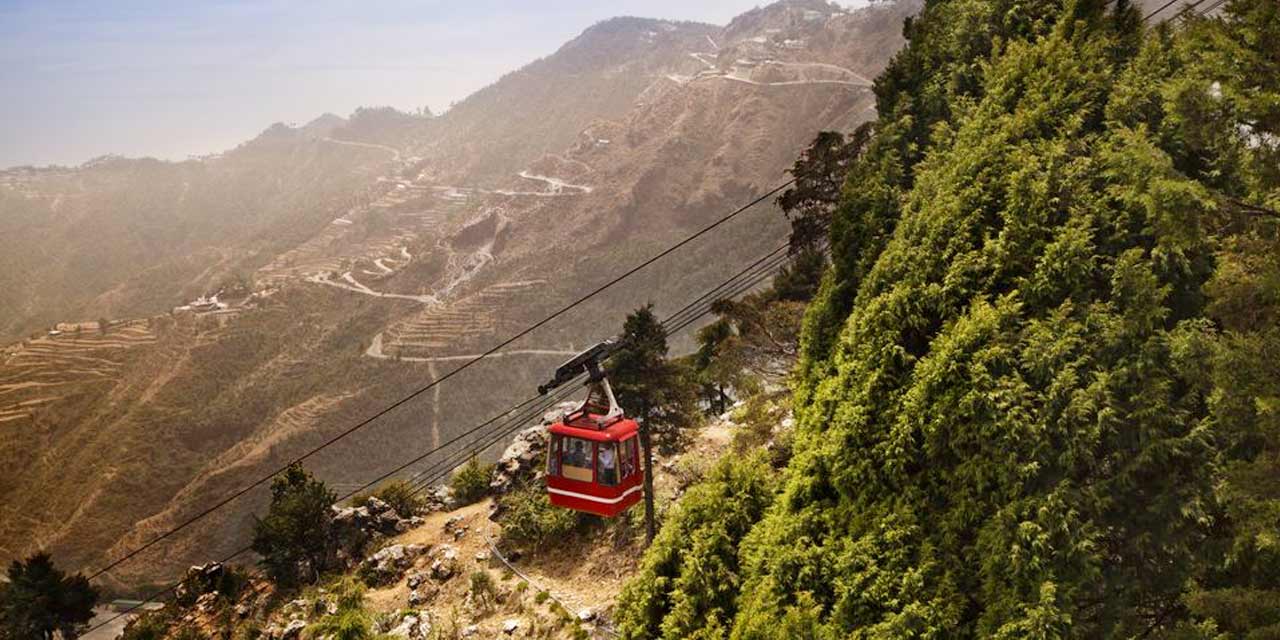
Gun Hill, Mussoorie
6. Jharipani Falls
If you’re someone who enjoys nature in its purest form, Jharipani Falls is a refreshing escape just a short drive away from the main town. Located near the quiet village of Jharipani, this scenic waterfall becomes especially breathtaking in August, when the monsoon rains feed its full force and the surrounding landscape turns into a dense canopy of vibrant greens.
The waterfall isn’t overly commercialized, which adds to its raw beauty. A short trek downhill (about 1 km) takes you through lush forest paths, and the sound of the waterfall grows louder with each step. By the time you reach the base, you’re greeted with a cool misty spray, ideal for a moment of pause, photos, or simply sitting and soaking in the view. The area is surrounded by wildflowers, mossy rocks, and thick vegetation — all thriving thanks to the August rains.
🕒 Opening Hours: 6:00 AM – 6:00 PM
🎟️ Entry Fee: Free
📍 How to Reach: Around 7 km from Mussoorie town; take a cab or drive to Jharipani village, followed by a 1 km downhill walk
Why Visit in August?
The waterfall is at its most powerful and picturesque during the monsoon. The weather is cool, the trek is comfortable (though slightly slippery, so wear good shoes), and the entire area feels like a secret hideout carved out by nature. It’s a great offbeat spot for travelers looking to avoid touristy crowds and enjoy Mussoorie’s monsoon charm up close.
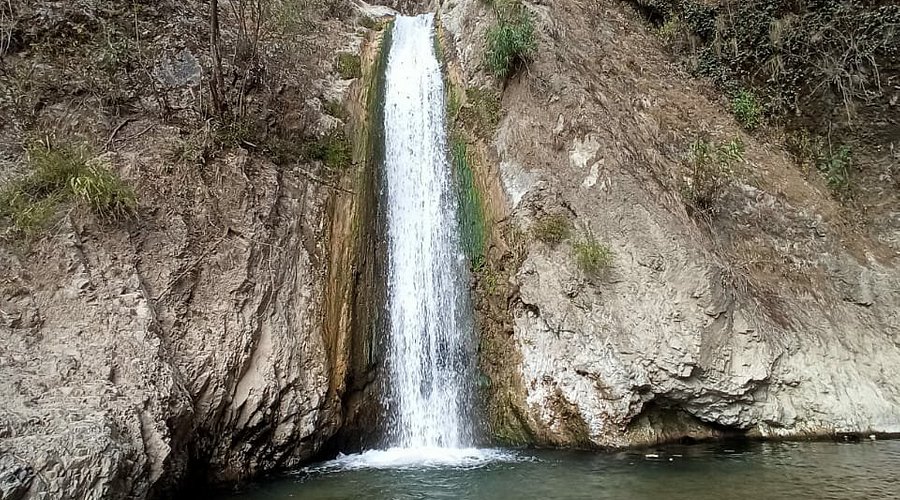
Jharipani Falls
7. Bhadraj Temple
Perched at about 7,500 ft on Bhadraj Hill—just beyond Cloud’s End—Bhadraj Temple is a serene spiritual destination and one of the best offbeat places to visit in Mussoorie in August. Dedicated to Lord Bal Bhadra (brother of Krishna), the temple is steeped in local lore involving divine intervention that rescued cattle from a mythical beast.
In August, the trail to Bhadraj is lined with lush forest and misty views, and the cooler hill weather (around 17–24 °C) makes the Milkman’s Trail trek (approximately 11 km long) both pleasant and scenic. Expect crisp mountain air, cloud-wrapped mornings, and panoramic views of the Doon Valley and the Himalayan foothills—perfect for meditation or mindful solitude.
A special attraction is the annual Bhadraj Fair (15–17 August), where devotional rituals, local music, and folk performances offer a peek into Garhwali culture—a unique monsoon-time experience.
🕒 Timings: 8:00 AM – 6:00 PM
🎟️ Entry Fee: Free
📍 How to Reach: About 11 km trek from Cloud’s End (via Dudhli village); accessible by taxi to Cloud’s End followed by the 8–11 km trek
Why Visit in August?
The monsoon breathes fresh energy into the trek and temple area—mist-laced forests, blooming wildflowers, and the devotional atmosphere of the fair. Despite occasional rain, the temple remains accessible, and pilgrims consider it spiritually potent this month.
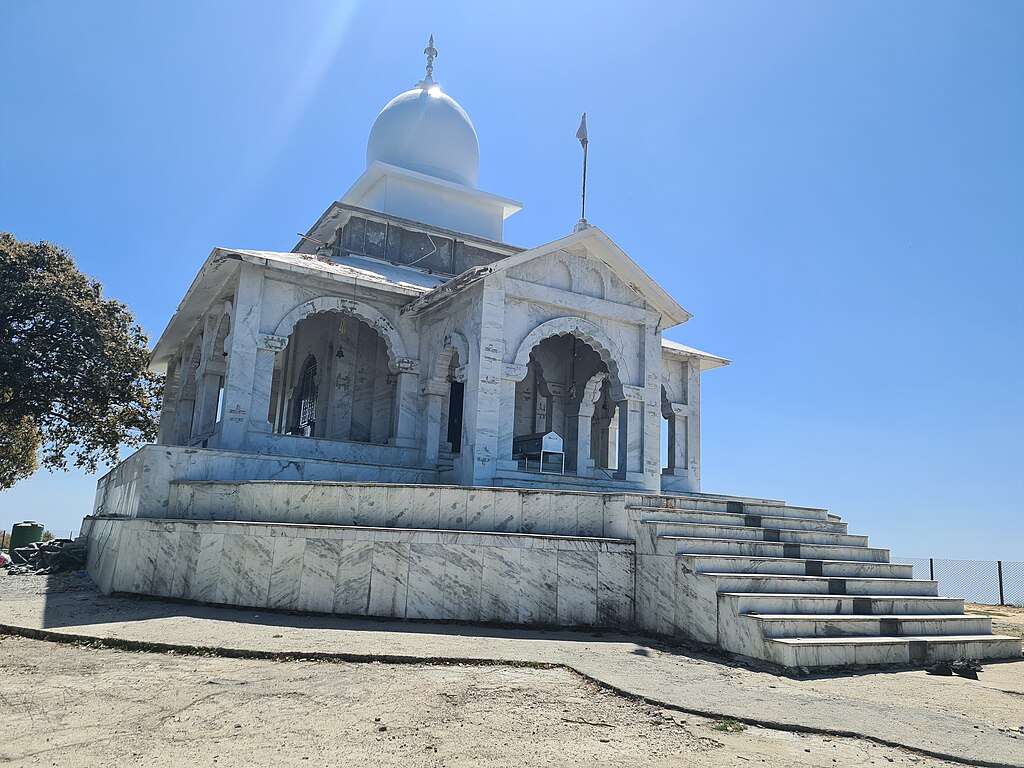
Bhadraj Temple
8. Benog Wildlife Sanctuary (Benog Hill)
One of the most enchanting places to visit in Mussoorie in August, Benog Wildlife Sanctuary (also known as Benog Hill) sits about 11 km from Library Point, offering a peaceful escape into Himalayan forest wilderness. Open daily from 7:00 AM to 5:00 PM, this sanctuary covers around 339 acres and is part of Rajaji National Park, with free entry to the sanctuary itself (permits required for deeper park access).
In August, this sanctuary comes alive: oak, pine, and deodar forests drip with monsoon moisture, colorful wildflowers carpet the meadows, and birdlife thrives—expect to spot rarities like the red-billed blue magpie and white-capped water redstart. Mammals such as Himalayan goats, deer, and possibly panthers or bears may also be sighted, making it a true wildlife haven.
From Cloud’s End, a pleasant trek of around 3–4 km brings you inside the sanctuary; more adventurous hikers can opt for the complete Benog Tibba Circuit trek (10–11 km), which leads to Savannah-like hilltops with sweeping views of Bandarpunch and Chaukhamba peaks.
🕒 Opening Hours: 7:00 AM – 5:00 PM (all week)
🎟️ Entry Fee: Free for sanctuary access (wildlife area requires ₹150 Indian / ₹600 foreign permit)
📍 How to Reach: Drive or trek from Cloud’s End (~3–4 km), or take a taxi from Mossoorie town to Sanctuary entrance
Why Visit in August?
The monsoon enhances every element of Benog—from misty forest trails to vibrant biodiversity. It’s a dreamy time to birdwatch, trek, or simply enjoy Himalayan sunshine filtering through newly green canopies without the usual tourist crowds.
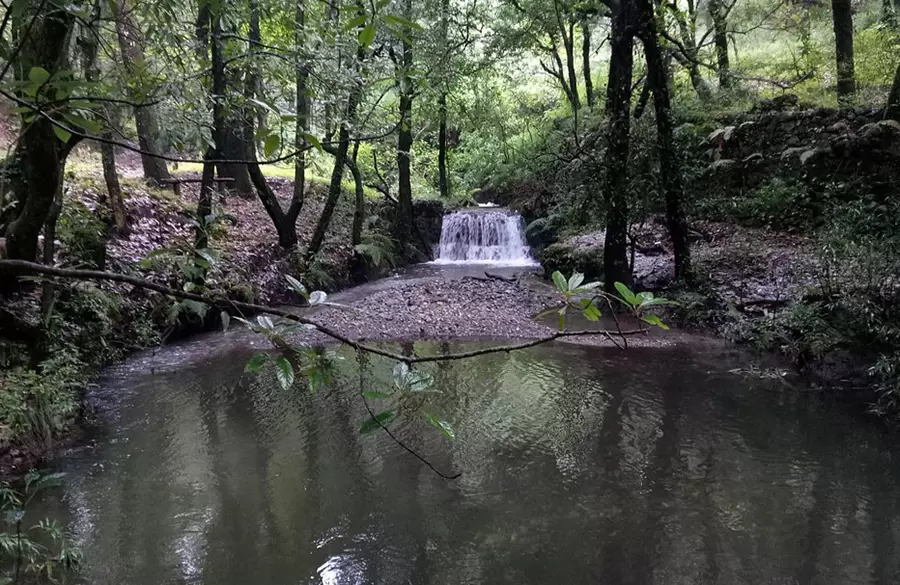
Benog Wildlife Sanctuary
9.Dalai Hills, Mussoorie
Tucked away in the peaceful Happy Valley area near the Tibetan Temple, Dalai Hills is one of the most tranquil and spiritual places to visit in Mussoorie in August. It’s not as widely known as other tourist spots, which makes it a hidden gem perfect for monsoon travel.
The highlight here is the massive golden Buddha statue that sits overlooking the misty Doon Valley — a serene spot that feels almost otherworldly in August when the hills are carpeted in green, the sky is overcast, and clouds gently roll across the ridges. The air is cool, the trails are quiet, and prayer flags flutter softly with the mountain breeze, adding to the spiritual atmosphere.
A short walk through pine forests leads you to this peaceful viewpoint, which also connects to the Tibetan Monastery (Shedup Choepelling Temple) and the historic Happy Valley, where the Dalai Lama first stayed when he came to India in 1959.
🕒 Opening Hours: Open all day (daylight hours recommended)
🎟️ Entry Fee: Free
📍 How to Reach: Around 3 km from Library Bazaar; take a short cab ride or enjoy a scenic walk via Happy Valley
Why Visit in August?
Dalai Hills offers a peaceful, introspective escape during the monsoon. It’s perfect for a mindful walk, quiet photography, or simply sitting in silence while watching the clouds drift through the valley. The light drizzle and the sound of prayer flags flapping in the breeze make it a deeply calming experience.
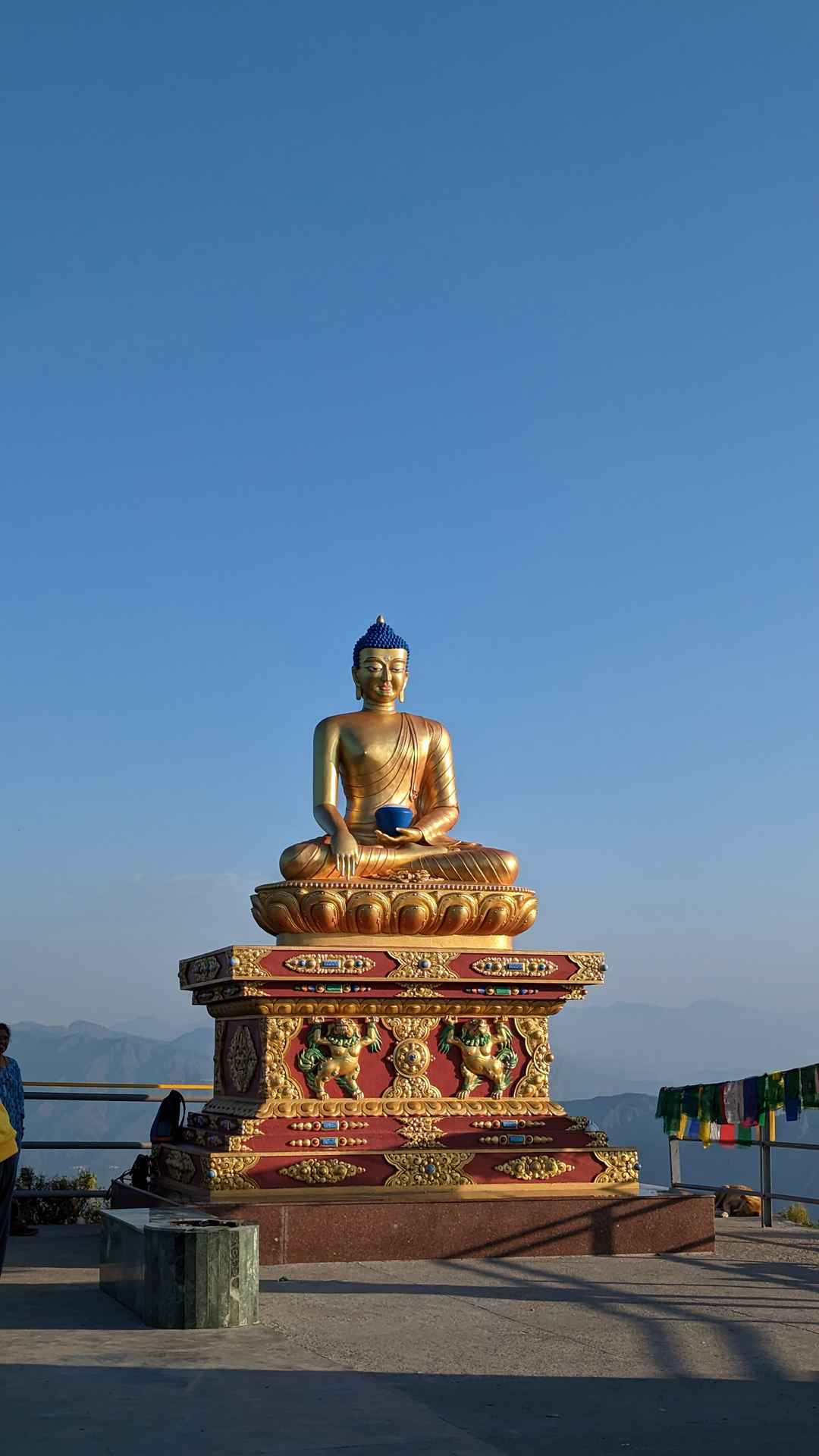
Dalai Hills Mussoorie
10. Library Chowk, Mussoorie
Library Chowk is the beating heart of town life—a vibrant junction where tourists, locals, and street vendors mingle under the wayward charm of colonial storefronts, rain-washed alleys, and mountain views. Visiting Library Chowk in August gives the best of both worlds: cool, misty weather and a lively but relaxed atmosphere.
August’s gentle drizzles create a mesmerizing ambiance—umbrella-draped crowds, steam rising from roadside maggi stalls, and colorful raincoats popping against grey skies. Unlike the bustling summer months, August mornings and late afternoons feel calm, giving you room to stroll around shops, sip tea at cozy cafés, or marvel at the street art lining the narrow alleyways.
🕒 Best Time to Visit: 10 AM–12 PM and 4 PM–7 PM (to avoid midday drizzle and enjoy evening tea)
🎟️ Entry Fee: Free
📍 How to Reach: Centrally located on Mall Road; walk in from any point in town or take an auto-rickshaw
Why Visit in August?
Library Chowk offers a sensory snapshot of Mussoorie’s character—friendly banter between shopkeepers, earthy petrichor smells, and the muted warmth of foggy streets. It’s the perfect place to soak in local culture without driving out of town—an essential stop for anyone truly experiencing Mussoorie in August.
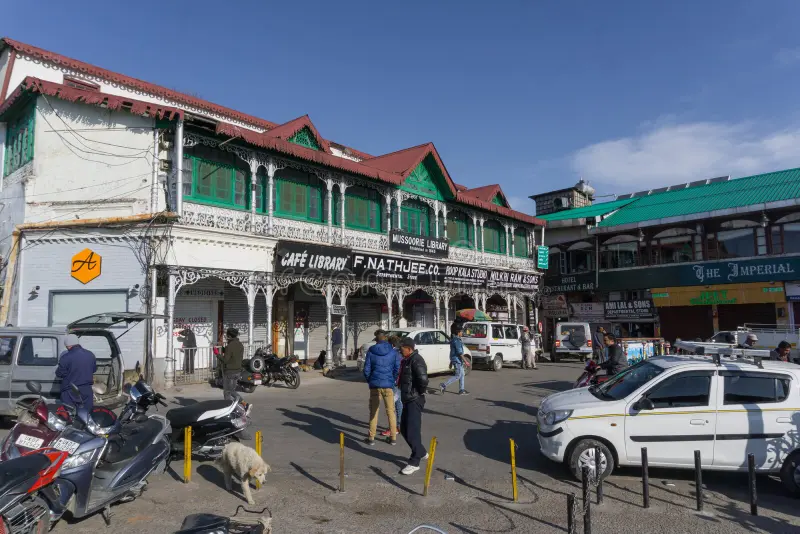
Library Chowk, Mussoorie
Things to Do in Mussoorie in August:Top Things to try in August 2025
Mussoorie in August is a blend of romantic rains, misty mountain air, and serene landscapes. While the monsoon may limit some high-altitude treks, it also unlocks a whole new personality in the town—one that’s slower, greener, and deeply refreshing. Whether you’re a nature lover, adventure seeker, or someone who just wants to slow down and unwind, there’s no shortage of things to do here. In fact, the rains often enhance the charm of these experiences.
Here are some of the most rewarding things to do in Mussoorie in August:
1. Take the Ropeway to Gun Hill and Watch the Clouds Drift Below You
Even though the Himalayan views from Gun Hill may be partially hidden behind clouds in August, the experience of riding the ropeway over mist-covered pine forests is a thrill in itself. Once at the top, you’ll often find yourself above the clouds—with floating white layers covering the valley like a soft blanket. It’s peaceful, surreal, and surprisingly uncrowded during monsoon months.
Spend some time walking around the circular viewpoint, grab a cup of hot tea or local snacks from nearby stalls, and enjoy the cool air that refreshes your senses. Occasionally, the clouds clear for a few minutes, giving you dramatic views of peaks like Bandarpunch and Srikantha. But even when they don’t, the mysterious mist and quietude offer an equally magical memory.
August makes the entire Gun Hill experience feel like stepping into a dreamscape. Just make sure to carry a light rain jacket and be cautious on slippery paths.
2. Hike to Cloud’s End for a Monsoon Forest Walk
If you’re someone who enjoys walking through nature when it’s at its most alive, hiking to Cloud’s End in August is an absolute must. The trail begins near Happy Valley and winds through a quiet forest of oak and deodar trees, made even more scenic by the fresh post-rain shine on every leaf. Birds chirp louder, the air feels cooler, and the path often disappears into a sea of mist—creating a feeling that’s both mysterious and meditative.
August is the perfect time for this hike because the monsoon fills the forest with wildflowers and dense greenery. The trail isn’t too steep, making it doable for most fitness levels, though waterproof shoes are a smart idea. The viewpoint at Cloud’s End offers breathtaking valley views if the skies clear—but even in full fog, the experience is rewarding.
There’s also an old British-era colonial bungalow nearby, adding a bit of heritage to your hike. This is the kind of experience that doesn’t rely on perfect weather—rain or shine, it’s an unforgettable connection to nature.
3. Try Local Food at Mall Road – Hot Meals, Mountain Views, and Monsoon Charm
If you truly want to experience Mussoorie in August, skip the big chains and head straight to the local eateries on Mall Road. Rain-soaked evenings on this iconic stretch are made for slow strolls, hot food, and peeking into cozy cafés as the mist drifts past glowing windowpanes.
August weather brings with it a chill in the air, which makes piping hot momos, Maggi, chole bhature, and butter-loaded parathas even more comforting. Some of the smaller Tibetan joints and old-school dhabas serve deeply satisfying meals, all while you watch clouds float by just outside. Pair that with a hot cup of ginger chai or a locally brewed coffee, and you’ve got a perfect mountain monsoon moment.
You’ll also find several bakeries and patisseries like Lovely Omelette Centre, Chick Chocolate, and Café by the Way, which offer delightful desserts and snacks with old-world charm. What makes August special is the way rain slows everything down—you’re not rushing through meals; you’re enjoying every bite, every view, every moment.
Dining in Mussoorie in monsoon isn’t just about the food—it’s about the experience. The warmth of the kitchens, the chatter inside, and the cold mist tapping at the windows—all come together to give you a memory that’s far more flavourful than just taste.
4. Visit a Waterfall Right After the Rain for the Most Spectacular View
There’s no better time than August to visit Mussoorie’s waterfalls—Kempty Falls, Jharipani Falls, or even the lesser-known Bhatta Falls—because the monsoon breathes life into them. The water volume is at its peak, the surrounding vegetation is vibrant, and the misty drizzle adds a cinematic charm to the entire setting.
Right after a rain spell, the falls gush with renewed energy, creating the perfect backdrop for photos, picnics, or simply soaking your feet in cool, rushing streams. While Kempty Falls is the most popular and commercialized, if you’re craving a quieter experience, head to Jharipani or Bhatta. These spots are less crowded in August and feel more raw and untouched, especially in the early mornings.
Do carry a rain poncho or a light jacket and wear good-grip shoes—paths can be slippery. Also, always follow local safety advisories and avoid standing too close to the edge of water streams.
Watching a waterfall thunder down after a fresh monsoon shower, with clouds drifting low and trees dripping with rain, is one of the most refreshing and grounding things you can do in Mussoorie in August.
5. Spend a Quiet Evening at Dalai Hills – For Peace, Views, and Mindful Moments
Tucked behind the Tibetan Temple in Happy Valley, Dalai Hills is one of the calmest and most peaceful corners of Mussoorie. While tourists often overlook it, those who venture here in August find a space filled with solitude, scenic beauty, and spiritual calm. The massive Buddha statue, surrounded by fluttering prayer flags, seems to glow against the misty hills — especially when the rain has just passed, and the skies begin to open up again.
In August, the whole area feels magical. The pine trees smell fresher, the walking path feels softer underfoot, and the cloudy valley views create a dreamlike experience. It’s the perfect place to disconnect from everything — sit on one of the benches, breathe in the mountain air, listen to the breeze rustling through the flags, and just be still.
You can also take a short walk to the nearby Shedup Choepelling Temple, which is both historically significant and a serene place for quiet reflection. If you’re someone who values mindful travel, photography, or writing, this spot is a goldmine in the monsoon.
There are no cafés or stalls here, which makes it even better for those looking to get away from the noise. Just carry a small umbrella, a notebook, and your camera — you’ll leave with peace of mind and a few unforgettable monsoon memories.
6. Attend the Bhadraj Temple Fair – A Spiritual and Cultural High in the Monsoon
If your Mussoorie trip happens to coincide with mid-August, you’re in for a rare experience — the Bhadraj Temple Fair, held annually from 15th to 17th August. Set atop Bhadraj Hill, this fair celebrates Lord Bal Bhadra (Lord Krishna’s brother) and draws pilgrims, villagers, and curious travelers from across the Garhwal region.
The trek to the temple, roughly 11 km from Cloud’s End, becomes especially scenic in August. The monsoon paints the trail in shades of deep green, the air is misty and fresh, and the occasional drizzle only adds to the adventure. Once at the top, the fair comes alive with local folk music, devotional chants, handicrafts, and Garhwali cuisine served by locals. It’s not just a religious event — it’s a cultural celebration where tradition, nature, and community come together.
You’ll witness a different side of Mussoorie — less touristy, more rooted in heritage. People gather to pray, celebrate, and share stories, all under colorful tents set against Himalayan backdrops.
It’s advisable to wear trekking shoes and carry rain gear if you plan to attend, and it’s best to start the hike early in the morning. The return trek offers equally mesmerizing views, especially if the clouds part to reveal the Doon Valley below.
7. Take a Day Trip to Landour – Misty Lanes, Ruskin Bond Vibes, and Colonial Charm
Just a short 4–5 km drive or walk uphill from Mussoorie’s bustling Mall Road lies Landour — a peaceful, old-world cantonment town frozen in time. In August, when the monsoon cloaks its winding roads in mist, Landour becomes even more atmospheric. Imagine walking along quiet lanes where every bend disappears into clouds, the scent of wet pine fills the air, and old colonial cottages peek through the fog. That’s Landour in the monsoon — moody, magical, and endlessly photogenic.
Start your day trip with a slow walk along The Landour Loop (also called Gol Chakkar). This circular trail covers charming spots like Char Dukan, St. Paul’s Church, Lal Tibba Scenic Point, and Ivy Cottage — believed to be where Ruskin Bond still resides. At Lal Tibba, on a clear monsoon break, you may catch glimpses of the snow-clad Himalayas. Even if the clouds cover them, the surreal ambiance more than makes up for it.
Stop by for a bite at Café Ivy, Char Dukan, or Rokeby Manor’s Emily’s Café — cozy spots that serve delicious meals and baked treats with panoramic valley views.
In August, Landour offers a quiet counterpoint to Mussoorie’s main town. Fewer tourists venture here in the rains, which gives you the rare luxury of solitude — perfect for reading, writing, strolling, or simply breathing in the monsoon-soaked serenity.
Clothes to Wear in Mussoorie in August – What to Pack for the Monsoon
If you’re planning a trip to the hills, knowing the right clothes to wear in Mussoorie in August can make your experience far more comfortable and enjoyable. Since this is peak monsoon season, you’ll need to pack for both rain protection and cool mountain air.
The weather during August stays pleasantly cool — temperatures range from 16°C to 24°C, with mild humidity and regular spells of rain. The mist, drizzle, and occasional downpours mean your outfit choices need to balance comfort, warmth, and waterproofing.
Start with lightweight, quick-dry clothing that won’t cling or feel heavy if it gets damp. Full-length pants, breathable cotton t-shirts, or long-sleeved tops are ideal for daytime wear. Since evenings can turn chilly — especially if it rains — carrying a light woolen sweater or a fleece jacket is a smart idea.
Here’s a quick guide to what you should pack — keeping the cool mountain climate, rainfall, and hilly terrain in mind:
Lightweight, Breathable Clothing:
During the day, temperatures stay mild (around 21–24°C), so pack cotton or quick-dry t-shirts, breathable full-length pants, or activewear that won’t stick to your skin during humid spells. Avoid denim, as it takes longer to dry if it gets wet.Layering Options – Sweaters or Fleece Jackets:
Evenings in Mussoorie drop to around 16–18°C, and with the added wind chill from passing showers, it’s best to carry a light woolen sweater or a warm hoodie. Layering is essential since the weather shifts quickly.Rain Gear:
August is a full monsoon month, so a good-quality raincoat or poncho, compact umbrella, and waterproof backpack cover are a must. Quick-dry towels also come in handy after surprise showers.Waterproof Footwear with Grip:
Slippery slopes and wet walkways are common this time of year. Waterproof hiking shoes or anti-skid sandals are far more practical than regular sneakers or flip-flops.Accessories for Comfort & Protection:
Don’t forget sunglasses, a hat or cap for UV protection during clear spells, and a small daypack to carry essentials on treks or local walks. A pair of extra socks will save your day if you get drenched unexpectedly.Optional Add-ons:
If you’re staying at a luxury resort with a heated pool or spa, a swimsuit might be worth packing too. Also, keep a thin scarf or muffler for extra warmth during early mornings.
| What to Pack | Why It’s Needed |
|---|---|
| Lightweight, breathable clothes | For daytime comfort in mild, humid weather (cotton shirts, quick-dry pants, etc.) |
| Light sweater or fleece jacket | To stay warm during cool evenings and sudden temperature drops |
| Raincoat / Poncho / Umbrella | Essential due to frequent showers during the monsoon season |
| Waterproof shoes with grip | To walk safely on wet, slippery roads and forest trails |
| Extra socks & quick-dry towel | Useful if feet get wet or caught in unexpected rain |
| Hat / Cap & Sunglasses | For UV protection during clear spells and open valley areas |
| Backpack with rain cover | Keeps your belongings dry while exploring during rain |
| Insect repellent | To prevent leech or bug bites on forest walks or during hikes |
| Swimwear (optional) | If your stay includes access to pools, spas, or waterfalls |
| Scarf or light muffler | Extra warmth and wind protection, especially in early mornings |
Does It Rain in Mussoorie in August?
Yes, it definitely rains in Mussoorie in August, and quite frequently too. August falls right in the heart of the monsoon season in Uttarakhand, which means you can expect intermittent showers, cloudy skies, and occasional heavy rainfall throughout the month.
On average, Mussoorie receives 300–400 mm of rainfall in August. However, the showers are rarely continuous all day. Most of the time, they come in short, intense bursts — especially in the late afternoon or night — followed by long stretches of cool, misty weather and clear air. Early mornings are usually calm and ideal for walks or sightseeing, while late evenings bring in fog and drizzles that give the town a cozy, romantic vibe.
The rainfall also brings out the best in Mussoorie’s natural beauty — waterfalls flow at full strength, forests are lush and breathing with life, and the town is wrapped in a blanket of fresh greenery and mountain mist. Roads and trekking paths may be slippery, so packing proper footwear and a good rain jacket is essential.
So, yes — it does rain in Mussoorie in August, but rather than being a downside, the monsoon adds a magical layer to the experience. For those who enjoy peaceful travel, fewer crowds, and nature at its wildest and most vivid, August rain in Mussoorie is a reason to go, not to stay away.
Why Mussoorie in August is a Hidden Gem in 2025
If you’re planning a scenic and soul-refreshing getaway in 2025, Mussoorie in August might just be the destination you didn’t know you needed. While many travelers hesitate to visit during the monsoon, August unveils a side of Mussoorie that’s more magical, more serene, and far more intimate than in peak season.
The hills are at their greenest, the waterfalls are at their fullest, and the air carries that unmistakable freshness that only comes after a mountain rain. With fewer crowds and mist wrapping the town in quiet beauty, everything — from a simple cup of tea at Mall Road to a hike through Cloud’s End or a walk in Landour — feels deeper, richer, and more personal.
Yes, there’s rain. But with the right clothes, a good umbrella, and the spirit to embrace the monsoon, it becomes part of the adventure. Whether you’re a nature lover, a spiritual seeker, a solo traveler, or a couple looking for a peaceful escape, a Mussoorie trip in August will reward you with misty mornings, dramatic landscapes, and moments of unexpected stillness.
So if you’re still wondering, is it safe to travel to Mussoorie in August? The answer is yes — and it just might be the most underrated time to experience the Queen of Hills.
